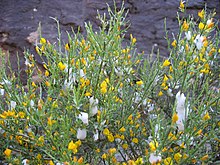Cuckoo spit
The cuckoo spit or cuckoo saliva , also known locally as witch's spit , is a common name for the foam nests of the leafhoppers in which their larvae live. The structures, which are reminiscent of spit, are found on stems and leaves of herbaceous plants or trees. The best- known example are the foam nests of the meadow foam cicada ( Philaenus spumarius ), which can often be seen on meadows in spring on the meadow foam herb ( Cardamine pratensis ) and which have given the plant their name.
The foam
The larvae have a respiratory cavity on their abdomen, which is likely to have arisen in the course of evolution from folds in the abdominal rings. The respiratory orifices (stigmata), the points where the trachea meet on the surface of the body, are located in the respiratory cavity . The trachea form a system of breathing tubes that runs through the entire body of an insect and is the functional equivalent of our lungs . The foam is generated by rhythmically pumping in air bubbles from the respiratory cavity into a protein-containing liquid, which the larvae secrete from the anus. This process continues until the imago leaves the excrement . The consistency of the foam can only be maintained because the animals excrete mucous substances ( glycosaminoglycans, formerly mucopolysaccharides ) and proteins from special excretory organs in the intestine ( Malpighian vessels ) . The foam also protects the larvae sitting in it from enemies, but primarily receives the moisture and temperature necessary for further development. Studies have shown that the foam of the meadow leaf hoppers ( Philaenus spumarius ) and the brown willow leaf hoppers ( Aphrophora salicina ) consists of 99.30% and 99.75% water, respectively.
Sometimes the foam flakes produced by the larvae of the colorful and brown willow cicada ( Aphrophora pectoralis, A. salicina ) appear so large and numerous in willows (Salix) that liquid drips out of them and, as it were, rains out of the tree. Commonly one speaks of "weeping willows".
The water-containing foam also provides the habitat for microscopic creatures, e.g. B. ciliate , and is thus an example of a zoo hotel .
mythology
Popular belief and legends said that the cicadas would also settle under the cuckoo's wings to torment it to death with their saliva. This would be the punishment for the bird throwing its foster siblings out of the nest and killing them.
Sources and further information

further reading
- R. Biedermann, R. Niedringhaus: The cicadas of Germany - identification tables for all kinds . Fründ, Scheeßel 2004, ISBN 3-00-012806-9 .
- M. Boulard: Diversité des Auchénorhynques Cicadomorphes Formes, couleurs et comportements (Diversité structurelle ou taxonomique Diversité particulière aux Cicadidés). (= Denisia. 4). Biology Center, Linz 2002, ISBN 3-85474-077-8 , pp. 171-214.
- H. Nickel: The leafhoppers and planthoppers of Germany (Hemiptera, Auchenorrhyncha): Patterns and strategies in a highly diverse group of phytophagous insects. Pensoft, Sofia / Moscow 2003, ISBN 954-642-169-3 .
Web links
Individual evidence
- ↑ JR Cryan: Molecular phylogeny of Cicadomorpha (Insecta: Hemiptera: Cicadoidea, Cercopoidea, and Membracoidea): adding evidence to controversy. In: Systematic Entomology. Volume 30, No. 4, October 2005, pp. 563-574.
- ↑ Hubert Ziegler, Irmgard Ziegler: About the composition of the cicada foam. In: Journal of Comparative Physiology . Volume 40, 1958, pp. 549-555.
- ↑ Handbook of Superstition. Volume 2: HO. Tosa, Vienna 1996, ISBN 3-85001-648-1 , p. 490.

